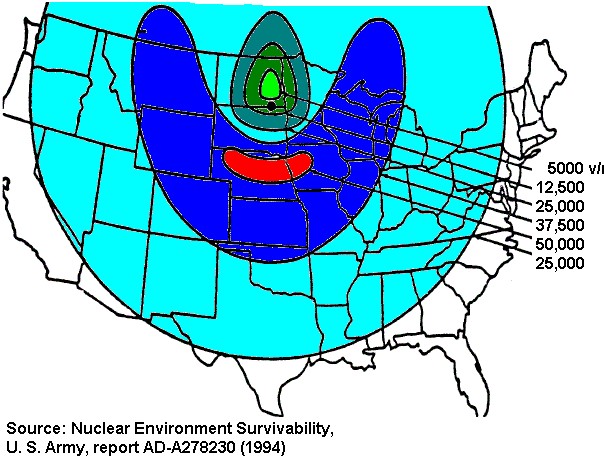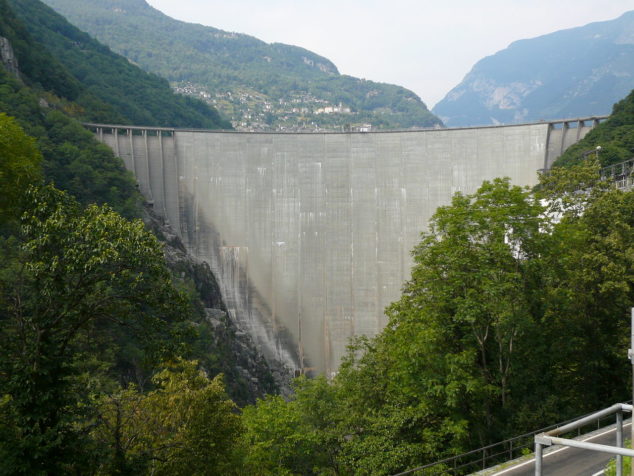People paid to worry about bad stuff happening concluded long ago that one way to destroy the USA as a functioning state would be to explode a high altitude nuclear weapon above the country; the resulting electromagnetic pulse (EMP) would destroy practically all electrical equipment, including the large transformers that make the electrical grid work. As it would take at least two years of the world’s total transformer manufacturing capacity to replace them, the US would be left with no electricity; and since everything depends on electricity, the US would collapse into chaos, disease and starvation.
This possibility is real: the US experimented with high-altitude nuclear tests in the early 1960s before atmospheric nuclear testing was banned. In the July 1962 Starfish Prime test, a 1.4 megaton warhead, was detonated 250 miles up in the North Pacific. The EMP, which was much larger than expected, knocked out street lamps, burglar alarms and a telephone microwave link in Honolulu, about 900 miles away, as well as several satellites.
The US set up a Commission to Assess the Threat to the United States from Electromagnetic Pulse (EMP) attack, which reported in 2008. Subsequent reports and committees have continued to investigate. Meanwhile the electricity grid remains unprotected. It would only take a single large warhead to hit most of the USA (see below).

If you think this sounds like the plot of a James Bond film, you’d be right. In the 1995 film Goldeneye, Bond has to prevent a disaffected British agent from using a Soviet-era EMP weapon to “send London back into the stone age” as revenge for the UK betraying his Cossack parents at the end of the Second World War. (It also has one of the most spectacular openings of any Bond film, a bungee jump off the 220m high Contra dam in Switzerland (see image below) – in the film it’s meant to be in Russia).
The Contra hydroelectric dam in Switzerland

The recent severe winter weather in Texas, which led to power cuts for millions of people, should remind us, if we needed it, of the importance of electricity to modern life. When I introduce my infrastructure finance elective each year, I often say that infrastructure is like the plumbing in our houses, we tend to take it for granted until it goes wrong and then we find it’s really important. But electricity is even more important than running water, which often depends on electricity for pumping.
Pretty much everything we do depends on electricity, including in the unfortunate case of many Texans, home heating. This reliance has only increased with the growth of the digital economy, which perhaps should be better known as the electronic economy, since all of that virtual and online data has to be stored on hardware, which must be kept powered on (and temperature controlled).
The risk of a grid collapse
Power cuts in developed nations are pretty rare, at least on a big scale. Texas is, electrically speaking, an island, deliberately isolated from the rest of the US power networks to avoid federal regulation (a longstanding Texan theme). A few parts of Texas, mainly in the far west and far east, are not part of the ERCOT grid system. For example the city of El Paso, which is connected to the western US grid, had only a few minutes of lost power because it could quickly get back up.
Great Britain is an actual island and so the need for a robust system has always been obvious. For many year we have had a limited amount of interconnection with France, more recently augmented by connections to Ireland and the Netherlands, and more are planned to Norway and Denmark. But Britain’s national grid (which serves England and Wales – Scotland’s system is connected but separate) was designed to withstand a range of calamities, with reserves always available, or if necessary a way of “shedding load” (cutting people off) without risking the grid collapsing.
A grid collapse reportedly was only a few minutes away in the case of Texas. Alternating current electricity systems are rather more complex than the direct current circuits you learn about in school (the difference between them is touched on in the entertaining film The Current War, on the unlikely subject of the competition between Thomas Edison and George Westinghouse for domination of the early US electrical industry). All generators are synchronised across the grid at a standard frequency (50Hz in the UK, 60Hz in the USA; Japan uses both, though obviously in different regions). Demand and supply for electricity must be matched at all times. If there is a shortage of supply (including from back up storage) then demand must be cut. If this process if mismanaged, or happens in an unplanned way, the frequency can drop, leading to further generators being forced off the grid. This is dangerous, as well as disruptive; in an uncontrolled shutdown the energy of the power station will mostly turn to heat , with the possibility of fires and explosions.
If a grid suffers a “cascading” collapse, with one power station after another being forced off the grid, and frequency falling further, there is then the huge problem of starting the system up again from scratch. In the case of Texas, without back up from the rest of the US, this could have taken weeks. Grid operators pay some generators for a “black start” capability, which is when a power station supplies its own electricity from a backup generator to begin generation. Most generators lack this capability: they require connection to the grid to begin generation. So they are literally powerless if the whole grid collapses.
The UK national grid reports that its 2019 reliability was an impressive 99.99997%. The only major breakdown in recent history was when the London grid was knocked out by the hurricane which hit southern England and northern France in 1987. Awoken by the exceptionally high winds and the worry that the roof of my student house might be falling down, I saw what London looked like with the power off (the grid operator chose to switch off the south east of England grid to avoid the risk of an unplanned and more damaging failure). We get so used to the level of light in a modern city that it is pretty strange and a little frightening to see true darkness.
The very high winds presumably deterred any burglars; London suffered storm damage but no looting, unlike the widespread looting following the New York City blackout of 1977. To be fair, New York was in a pretty bad way in the late 1970s, nearly bankrupt and facing a rising crime wave. When most of the north east US, including New York, was blacked out in August 2003, following a series of failures including power lines touching trees (seriously), people were far better behaved and there were many instances of neighbourly behaviour, possibly connected to the recent memory of the terrorist attacks on the city on September 11, just two years earlier.
A warning of how fragile our civilisation is
Robert Harris begins his 2020 novel The Second Sleep on a wet, dark night with a monk riding a horse through what at first seems to be pre-industrial England. It later becomes clear that this is the future, some centuries after an unexplained catastrophe that destroyed our high technology civilisation. The people of this distant future have little knowledge of our time, because so much of it was virtual. Whereas books and other physical objects from pre-industrial times have survived, the electronic devices and their online contents from the late 20th and early 21st century world are just plastic junk, leaving our puzzled descendants wondering what they were used for and what kind of world they have lost.
Perhaps you think the threat of an EMP is too far fetched. In its latest National Preparedness Report, published in December 2020, the US Federal Emergency Management Agency (FEMA) lists seven “catastrophic risks”, including earthquake, pandemics and nuclear and biological attacks on US cities. One of the seven is “space weather: a severe magnetic storm that results in power outages across most of the continental United States.”
We have been warned.


Leave a Reply